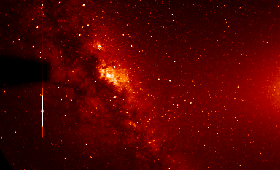
The Heliospheric Imager for the NASA STEREO Mission
Part of the SECCHI Consortium
About HI
 The HI is a wide-angle visible-light imaging system for the
detection of coronal mass ejection (CME) events in interplanetary
space and, in particular, of events directed towards the Earth.
The HI is a wide-angle visible-light imaging system for the
detection of coronal mass ejection (CME) events in interplanetary
space and, in particular, of events directed towards the Earth.
The protective covers, or doors, of the HI instruments were opened
at the end of 2006 and early in 2007 on the two spacecraft
revealing an unprecedented view of the space between the Sun and
the Earth. Within the first months of operation, HI had observed
the dark-side of the Moon, several CMEs, asteroids and, in the
very first images received from HI-B, a spectacular view of comet
McNaught.
Since then, in addition to observing and cataloging many more CME,
the HI instruments have made a number of spectacular observations
and discoveries, including:
- The impact of a CME on Venus and the interpretation of its
effects by comparing HI images with data received from spacecraft
in orbit around the planet
- The collision of a CME with a comet, resulting in the stripping
off (or "disconnection") of the comet's tail
- The discovery of the element iron, in atomic form, in the tail
of a comet
- The imaging for the first time of the very faint optical
emission associated with so-called Corotating Interaction Regions
(CIRs) in interplanetary space, where fast-flowing Solar wind
catches up with slower wind regions
The HI instrument has been developed by a UK-led consortium which
includes the Centre Spatial de Liege, Belgium, and the Naval
Research Laboratory, USA. The UK Team
